Control of Movement: Basal Ganglia and the Cerebellum
1/61
There's no tags or description
Looks like no tags are added yet.
Name | Mastery | Learn | Test | Matching | Spaced |
|---|
No study sessions yet.
62 Terms
Basal Ganglia and Cerebellum – can be considered part of the ________ system
extrapyramidal
essential function of extrapyramidal system?
maintaining posture and regulating involuntary motor functions
•Postural tone adjustment
•Performing movements that make voluntary movements more natural and correct
•Control of automatic modifications of tone and movements
•Control of the reflexes that accompany the responses to affective and attentive situations (reactions)
•Control of the movements that are originally voluntary but then become automatic through exercise and learning (e.g., in writing)
•Inhibition of involuntary movements (hyperkinesias), which are particularly evident in extrapyramidal diseases
the basal ganglia is a group of …?
subcortical nuclei
what is the main component of the basal ganglia?
striatum with several subpartswhat ar
what are the subparts of the striatum of basal ganglia?
caudate nucleus, putamen, substantia nigra, globus pallidus, and nucleus accumbens
the basal ganglia is important in action selection. what does this mean?
deciding which of several possible behaviors to execute at a given time and regulating them so that motor movements are performed smoothly
specific areas of the basal ganglia called substantia nigra are involved in
dopamine release and brains reward system
what is the Primary region of the brain for controlling movement?
primary motor cortex
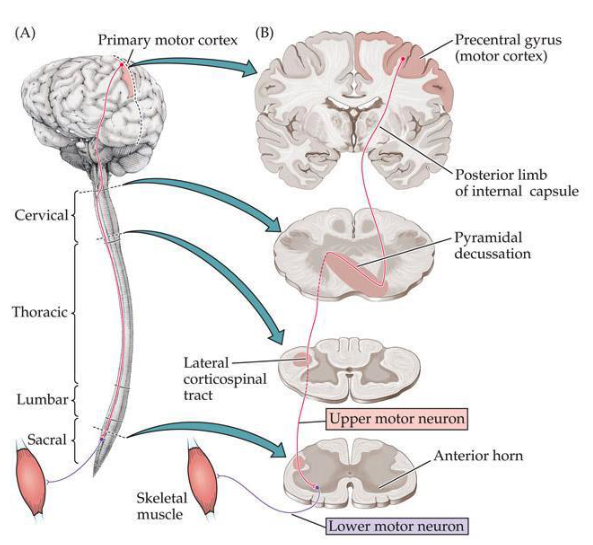
describe the corticopsinal pathway
Upper motor neurons in layer V of the primary motor cortex (precentral gyrus), send long axons that will decussate in the medullary pyramids
axons travel down the spinal cord via the lateral corticospinal tract
synapse directly onto the alpha (lower) motor neurons in the ventral horn and also onto the interneuron circuitry of the spinal cord
why do we think the basal ganglia and cerebellum are involved in movement?
Neurodegenerative movement disorders where there is damage to the basal ganglia or cerebellum demonstrates their role in controlling movement
damage to the basal ganglia can cause what neurodegenerative movement disorders?
Huntington’s Disease
Parkinsons’s Disease
Tourette’s Syndrome
damage to the cerebellum can cause what neurodegenerative movement disorders?
Ataxia - Can initiate movements but they are not accurate
The Basal Ganglia consist of # paired structures deep in the center of the brain that are involved primarily in …?
five
the control and initiation of movement
what are the 5 paired structures deep in the center of brain that the basal ganglia consists of?
1) The Caudate
2) The Putamen
3) The Globus Pallidus
4) The Subthalamic nucleus
5) The Substantia Nigra
These structures are not visible externally but are prominent in coronal and axial sections

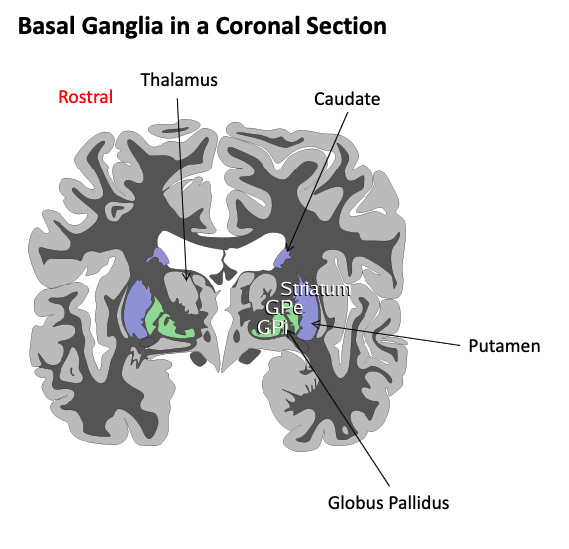
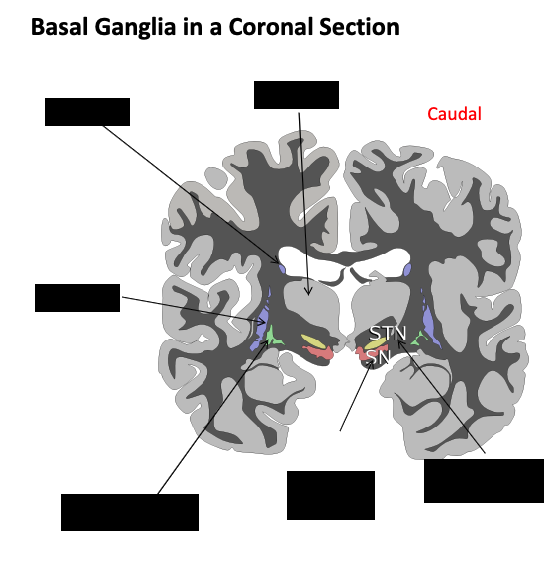
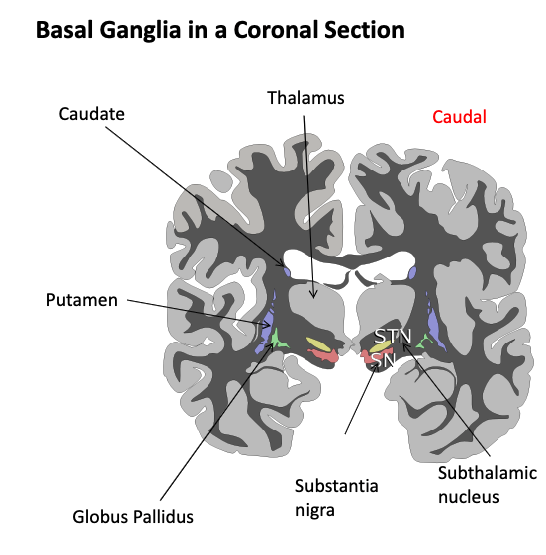
The basal ganglia (caudate nucleus, putamen, globus pallidus, subthalamic nucleus, and substantia nigra) are considered part of the_________ system
extrapyramidal
The basal ganglia direct their output mainly through the
thalamus to the cerebral cortex
Most neural lesions that cause movement disorders occur in the _________ system
extrapyramidal system; thus, these movement disorders are sometimes called extrapyramidal disorders
what is the function of basal ganglia?
basal ganglia makes a loop with thalamus and cortex to release appropriate movements from premotor and motor areas
release appropriate behaviors from prefrontal association areas.
select a particular movement or sequence of movements, or behaviors, while suppressing others, Ex) Tourette’s syndrome
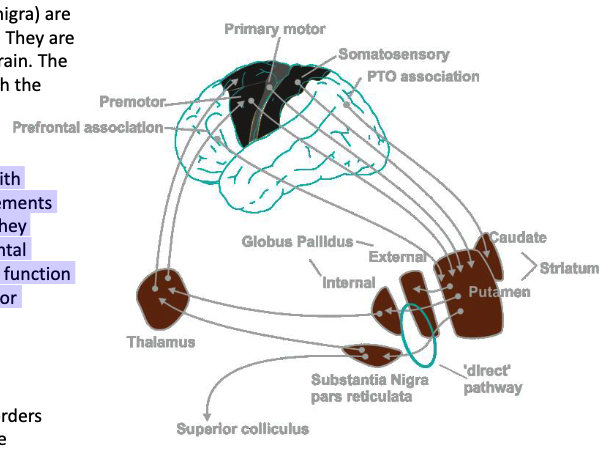
what are the 2 pathways within the basal ganglia? and what do they each do?
direct pathway → stimulates appropriate movements through disinhibition
indirect pathway → inhibits specific inappropriate movements (further suppress competing movements)
how do the basal ganglia stimulate appropriate movements via the direct and indirect pathways?
basal ganglia normally exert a constant inhibitory influence on thalamic regions that excite premotor and motor cortex
prevent them from becoming active at inappropriate times.
To initiate a movement, Direct Pathway removes brakes from thalamus releasing selected movements and behaviors from the cortex, so it stimulates appropriate movements.
The indirect pathway inhibits specific inappropriate movements and suppresses competing movements
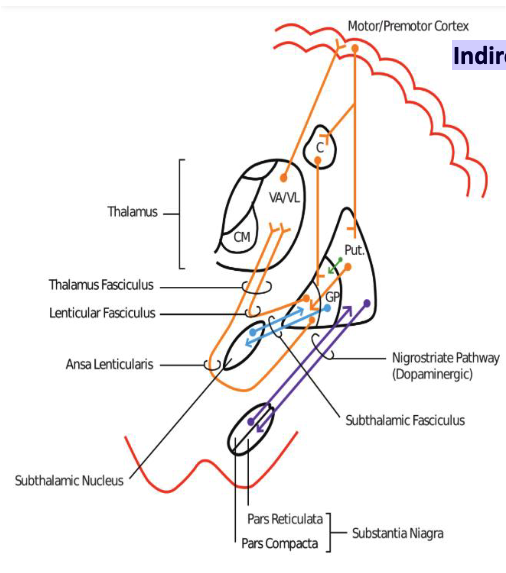
the substantia nigra projects to the _____
putamen (nigrostrial pathway)
describe the nigrostrial pathway
dopamine is the neurotransmitter
has activating effect on direct pathway
has inhibitory effect on indirect pathway
what is dopamine thumb?
involved in reward system and also in searching/seeking/arousal system which creates a loop when you’re scrolling on your phone
Loss of dopamanergic neurons in the Substantia results in what disease?
Parkinson's Disease, which is characterized by a difficulty in initiating movements
epidemilogy of Parkinson’s disease?
• Mean age of onset 55-60 years of age
• 1-3% of population above age of 60
• Slight male preponderance
• Vast majority are idiopathic (of unknown origin)
main symptoms of Parkinson’s disease?
• Bradykinesia (abnormal slowness of movement)
• Resting Tremor (rhythmic motion in fingers)
• Rigidity
• Postural Instability (shuffling gait)
(bradykinesia +1 is diagnostic of Parkinson’s)
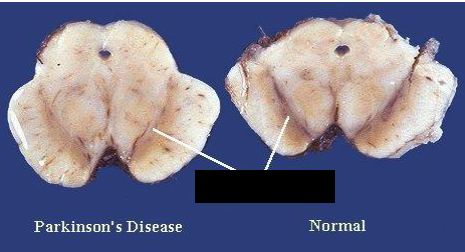
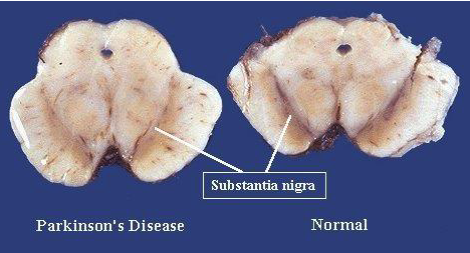
there are ___ per 100,000 in US with Huntington’s disease.
2-10 (prevalence worldwide is variable)
what are genetic causes of Huntington’s disease?
Chromosome 4, AD
“Huntingtin” mutant form creates aggregates in striatum
Likely several independent mutations
unknown function
ubiquitous (not just CNS)
CAG repeat
# correlates with severity, inversely to age of onset
< 36 normal, 36-39 intermediate, 40+ HD
signs of Huntington’s disease
-Involuntary jerking or writhing movements (chorea)
-Muscle problems, such as rigidity or muscle contracture (dystonia)
-Slow or abnormal eye movements
-Impaired gait, posture and balance
-Difficulty with speech or swallowing
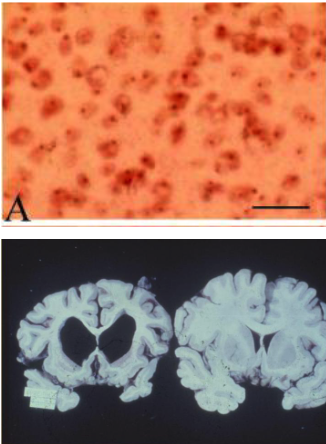
black dots are aggregates of huntington proteins
Spinocerebellar Pathways terminate in the ______
cerebellum
Dorsal Spinocerebellar/Cuneocerebellar (DSC): function
Conveys muscle sense information which is used by the cerebellum to coordinate movement and posture. It collects information about individual muscles
Dorsal Spinocerebellar/Cuneocerebellar (DSC): receptors and afferents
Muscle spindles and golgi tendon organs
Thick and highly myelinated afferents
Dorsal Spinocerebellar/Cuneocerebellar (DSC): first order sensory neurons
Located at the dorsal root ganglia (DRG), afferent fibers enter the spinal cord and stay in the same side in the lateral part of the lateral funiculus
Dorsal Spinocerebellar/Cuneocerebellar (DSC): decussation
Fibers do not cross the midline and stay always in the same side
The bulk of the structure of the cerebellum is made up of a very tightly folded layer of gray matter called?
the cerebellar cortex (but also contains white matter tracts and 4 deep nuclei)

t/f: the cerebellum contains more neurons than the rest of the brain put together, but it only takes up 10% of total brain volume
true
how many layers does the cerebellar cortex have?
3
what is the major goal of the cerebrella cortex?
regulate the gain and timing of motor actions (movements), i.e., coordination
The cerebellar cortex has a great amount of synaptic plasticity. What does this allow?
allows continuous adjustment and fine tuning – learning how to do movements
Synapses in the cerebellar cortex are very sensitive to what substance?
alcohol
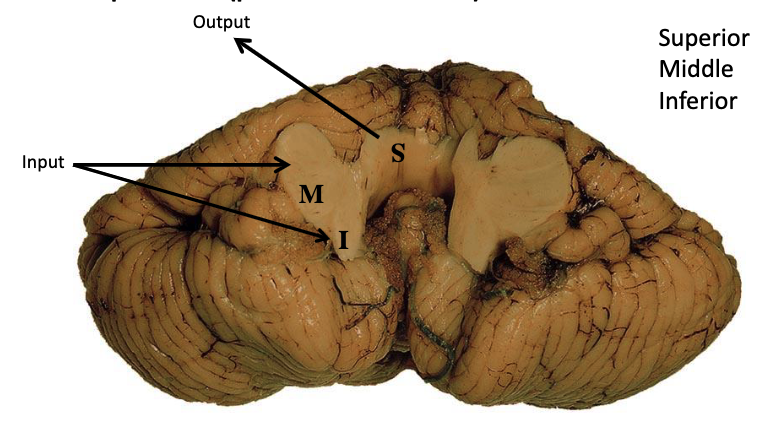
what are these?
cerebella peduncles
which cerebellar peduncle receives input? output?
output → superior
input → middle + inferior
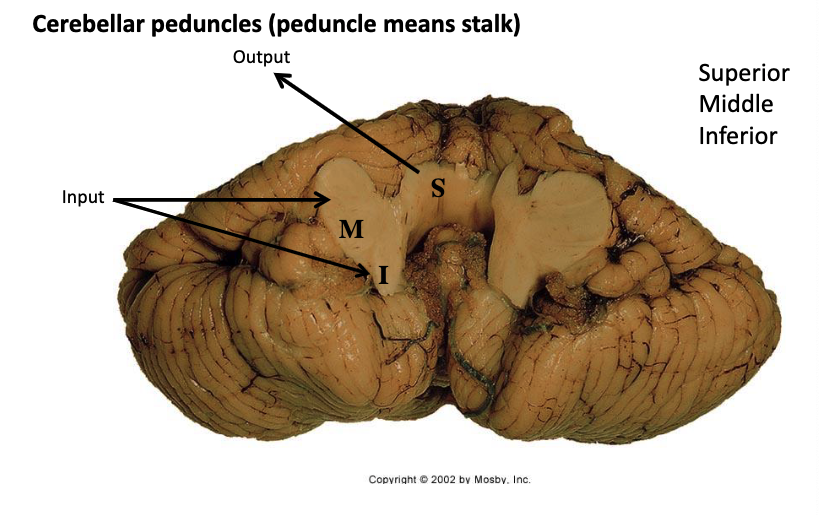
Cerebellar input travels through the ___ to the _________ from ____ to integrate motor function and proprioceptive sensation
pons; cerebellum; cortex and spinal cord
cerebellar input is important in coordinating…?
amount of force used when doing an action
Think about lifting a box that was much lighter than you thought it was going to be..
Cerebellar output is through # deep nuclei of the cerebellum
4
which cerebellar deep nucelus is responsible for planning, initiation and control of voluntary movements and also contains output channels involved in motor function through the thalamus?
dentate nucleus
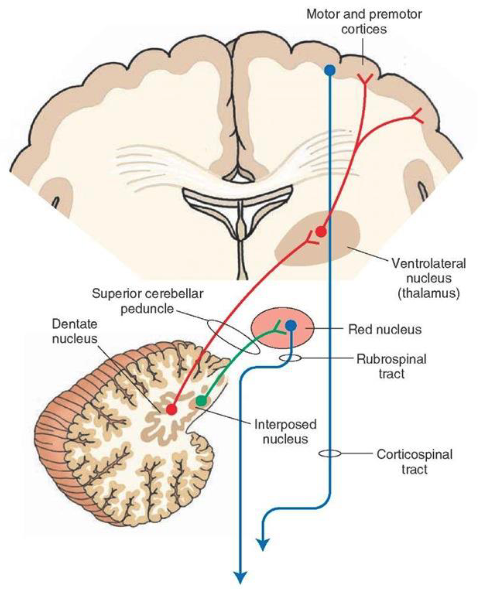
which cerebellar deep nucleus is responsibel for regulating saccadic eye movements and estimating movement of the body through space?
fastigial nucleus
In humans, Emboliform and globose nuclei make up the _______ nucleus.
interposed
the interposed nucleus is involved in what functions?
coordinating agonist/antagonist muscle pairs.
lesions in the area of interposed nucleus can result in what clinical presentation?
tremors
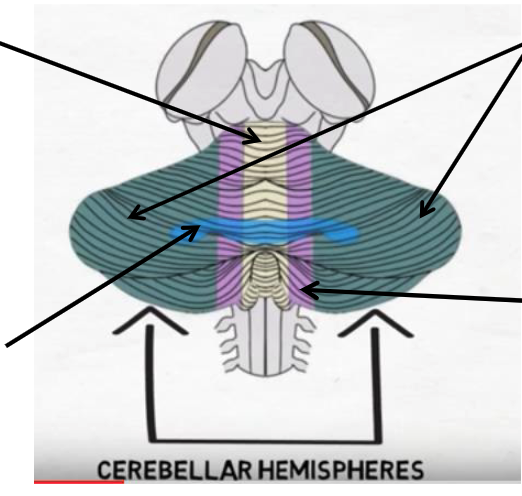
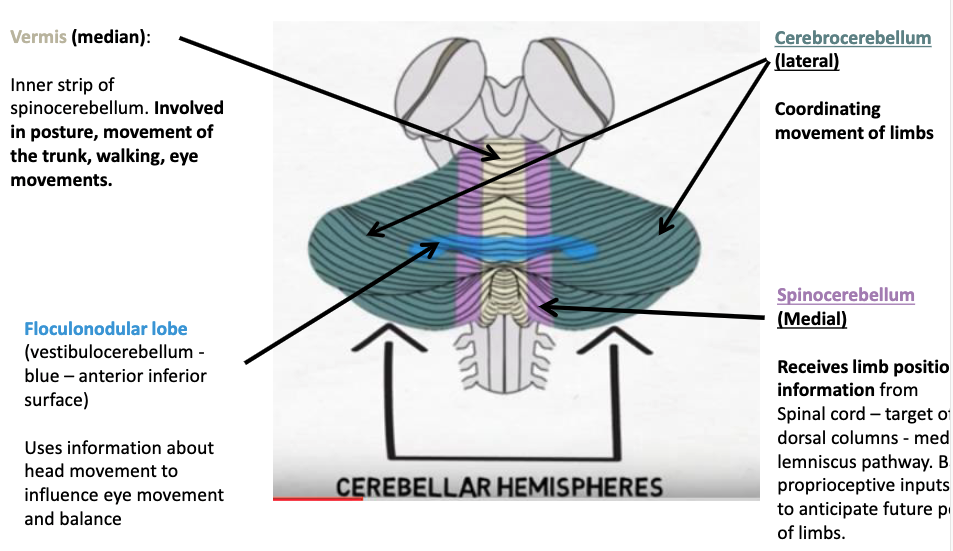
which portion of the cerebellar cortex is involved in posture, movement of the trunk, walking, eye movements?
vermis (inner strip of spinocerebellum)
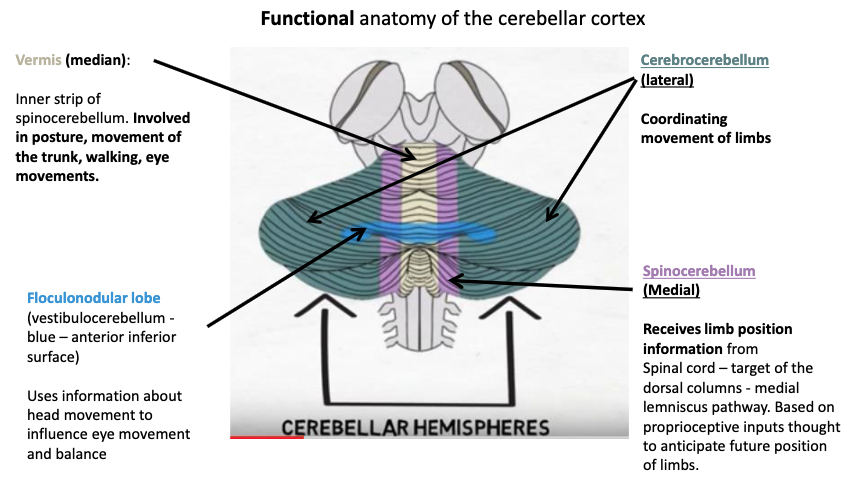
which portion of the cerebellar cortex is involved in coordinating movement of limbs?
cerebrocerebellum (lateral)
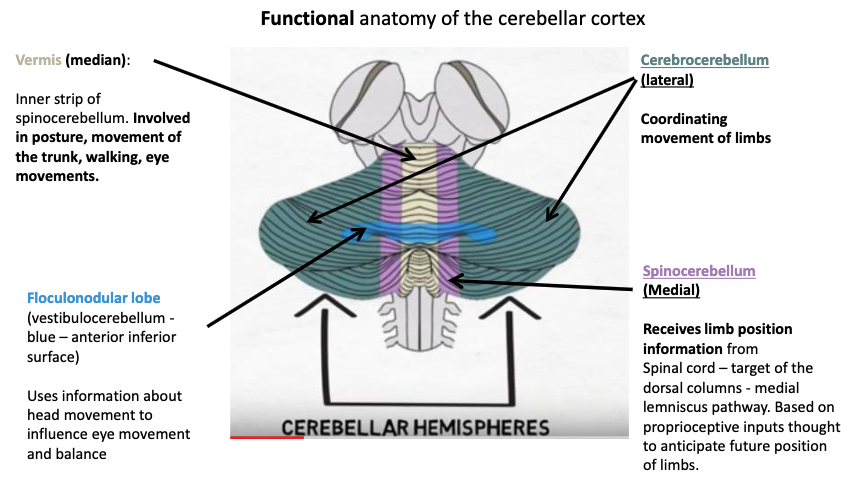
which portion of the cerebellar cortex is involved in receiving limb position information from the spinal cord?
Spinocerebellum (Medial)
Based on proprioceptive inputs thought to anticipate future position of limbs
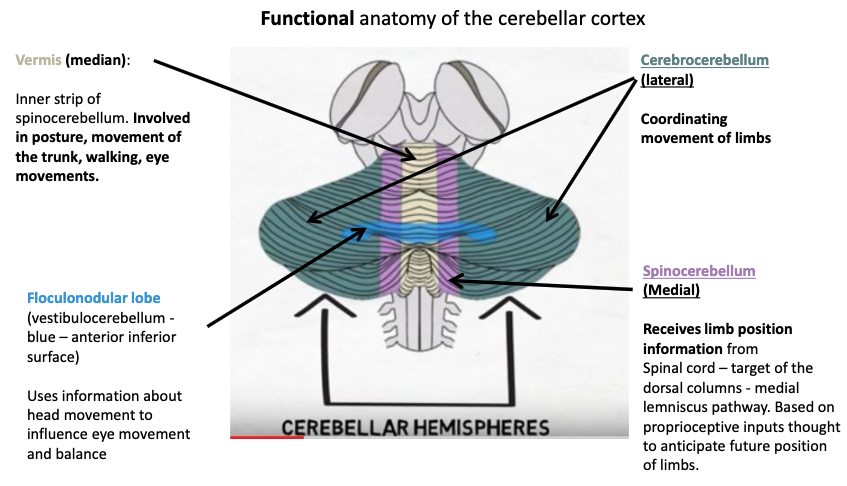
which portion of the cerebellar cortex uses information about head movement to influence eye movement and balance?
floculonodular lobe (anterior inferior surface)
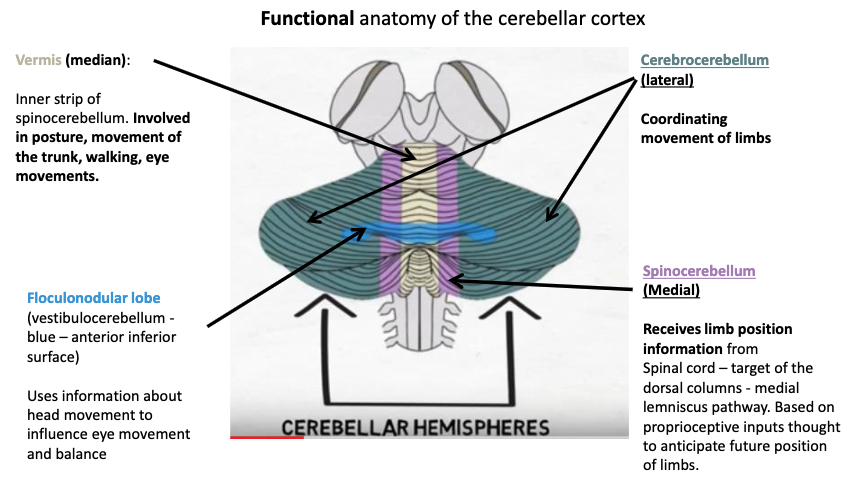
Cerebellar dysfunction results in uncoordinated:
• walking (vermis)
• limb movements (cerebrocerebellum)
• muscles of speech (many parts)
• Eye movement (floculonodular lobe - Nystagmus –rapid, uncoordinated eye movements)
Cerebellar Syndromes – archetypal is
ataxia (inaccurate movements)